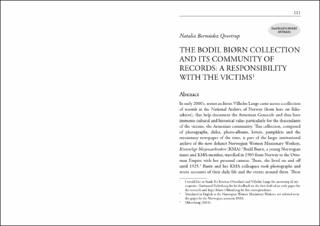The Bodil Biørn collection and its community of records: A responsibility with the victims
Peer reviewed, Journal article
Published version
Permanent lenke
https://hdl.handle.net/11250/2826443Utgivelsesdato
2021Metadata
Vis full innførselSamlinger
Originalversjon
Norsk arkivforum. 2021, (27), 111-142.Sammendrag
In early 2000’s, senior archivist Vilhelm Lange came across a collection
of records at the National Archive of Norway (from here on Riksarkivet), that help document the Armenian Genocide and thus have
immense cultural and historical value particularly for the descendants
of the victims, the Armenian community. This collection, composed
of photographs, slides, photo-albums, letters, pamphlets and the
missionary newspaper of the time, is part of the larger institutional
archive of the now defunct Norwegian Women Missionary Workers,
Kvinnelige Misjonsarbeidere (KMA).2Bodil Biørn, a young Norwegian
nurse and KMA member, travelled in 1905 from Norway to the Ottoman Empire with her personal camera. There, she lived on and off
until 1925.3
Biørn and her KMA colleagues took photographs and
wrote accounts of their daily life and the events around them. These records would later take on a life of their own and a meaning beyond
Biørn, the KMA and Norway. The story of this collection begins with
the story of Bodil Biørn’s missionary work in Armenia, yet as I will
describe here, goes beyond the narrative of the Nordic missionaries
showing us how records travel through contexts and time to be activated for different purposes, and the fundamental role that archives play
in their activation. This is particularly the case in this digital age.
The paper shows the importance of a community of records in cases
of atrocity, for contextualisation, a deeper understanding of historical
events and respect for the victims. A community of records is described
as ‘both to how records are (re-)created or reused within a community
as well as its contextualization of records (through memory and narrative construction)’.4
This community of records, a community that has
a stake and an interest in the records, has helped activate the records in
the Bodil Biørn collection and prolong their life in the service to which
they were intended by Biørn, helping the Armenian community. This
paper shows the participative nature of archivists and archives making
them more than spectators but active participants in the politics of
remembering.
It is a case of third-country sharing5
and the collaborative efforts of a
national archive to promote remembrance and acknowledgement of
genocide, in opposition to the political stand taken by the Norwegian
government. Digitalisation has extended the lives of these records, as
is central to the sharing process with partners such as the Armenian
Genocide Museum, Wikimedia, documentary film-makers, authors and with other projects. Yet, an online life raises concerns of erratic use
that decontextualises and disconnects records from their community
and memory institutions, which can at least be made accountable for
their narratives.
